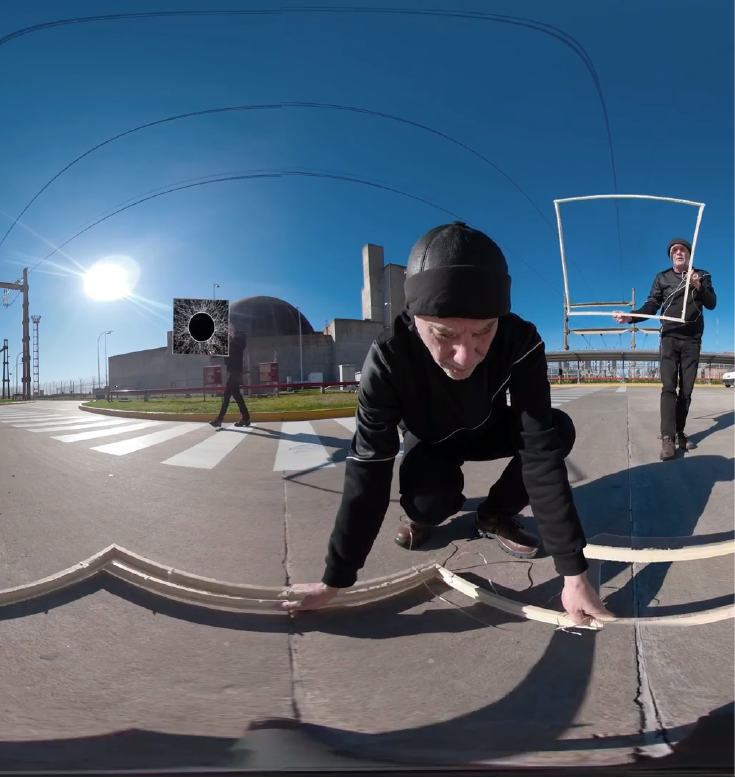
Carlos Trilnick. "Paisajes políticos" by Marcela Römer
Viajando por América, 1989
Zona Cero, 2019
Proyecto Minas antipersonales, 2009
Libertad, Igualdad, Fraternidad, 2005
Tierra del Fuego, 2006
No se puede postergar el tiempo, 2018
Mar, 2003
Interview to Marcela Römer, curator of the exhibition
Texts´selection
Carlos Trilnick
Paisajes Políticos
By Marcela Römer
This homage to Carlos Trilnick, a pioneer of video art in Argentina, brings together a selection of works that illustrate how his interest in technology led him to experiment with various platforms and mediums.
The different political landscapes are constructed based on his fascination with the electronic image, conceived as a process of scanning electrical impulses that illuminate one point after another successively. This concept, which may seem technical and specific, is closely related to the temporality and the actual execution of what can be perceived, becoming the central idea that runs through his entire artistic production and teaching career.
Trilnick always maintained a clear ideological stance related to the defense of human rights, respect for natural ecological processes unaffected by predatory industrialization, and the construction of visual imagery focused on mechanisms rather than just final outcomes.
Artistic political processes serve as a stimulus in his quest for experimentation, and in that sense, he focuses his concern on education as a transformative tool for reality. The legacy of his work consists of a vast network that propels processes much like the constant movement of an image in motion.
Viajando por América, 1989
Video Installation Video Music
Archivo Carlos Trilnick
Carlos Trilnick
Carlos Trilnick y Alfred Olivieri
Viajando por América is an installation with three monitors characteristic of the time it was conceived. In the artist's words, their arrangement simulates a Möbius strip. It is a piece that visually relates to the idea of infinity, in a non-orientable and semi-fixed manner for the viewer. The images are generated from pre-Hispanic circular designs that, due to the effects of analog video, rotate upon themselves, creating the illusion of continuous movement and intertwining.
The installative version of the artwork was first exhibited at the National Museum of Fine Arts in Buenos Aires during the International Video Art Exhibition in 1990. The single-channel version of the piece received the Sin Cortes Magazine Award (1989) in 1990.
Zona Cero, 2019
360° Color 5K Video, designed for viewing on virtual reality headsets
4 minutes
Carlos Trilnick Archive
Video by Carlos Trilnick
Logistics by Juan I. Acevedo, Eduardo Imasaka, Mariano Ramis
Production by Luciana Malavolta
Editing by Javier De Azkue
Sound by Pablo Trilnick
The video performance conducted at the Atucha I nuclear power plant in Buenos Aires, titled "Ground Zero," is an unprecedented work where the artist himself is seen exploring the contaminating spaces left suspended for years by atomic waste, spaces that are impossible to control. These free atomic particles, generators of energy, are virtually halted for a brief moment by black frames that the artist holds in space.
The work is based on the multiplicity of probabilities that a body may be in a specific place rather than another, involving "quantum leaps" or random, unpredictable, and/or chaotic changes of state within the same physical environment. It presents a non-anthropocentric ecological perspective on the danger of manipulating atoms simultaneously at the four cardinal points of the planet.
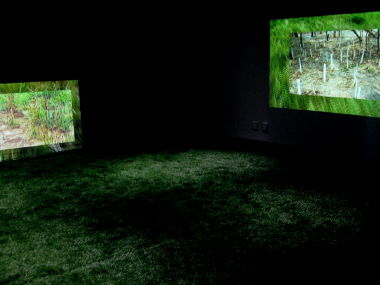
Minas antipersonales, 2009
Interactive Installation and Intervention in La Escalera
Variable Dimensions
Carlos Trilnick Archive
Interactive Installation Design by Diego Alberti
This project was conceived as a site-specific installation for the Calit2 Gallery at the University of California, San Diego (USA). It addresses the proliferation of landmines, which primarily affect farmers and animals. The artwork was installed in a gallery located where there used to be a military field and in an area of California where such weapons are currently still manufactured. The United States, along with China, Russia, North and South Korea, Egypt, Iran, and Cuba, among a few other countries worldwide, are the only ones that have not signed the 1997 Ottawa Treaties proposing the destruction of arsenals and a halt to their production. It is estimated that there are over 110 million landmines planted in 64 countries around the world.
The installation consisted of two parts: an initial intervention in the public space surrounding the gallery building featuring warning signs about minefields in twelve languages, simulating the danger of navigating such an area. Inside the gallery, documentary material about this action was displayed. The second part included an interactive area within the gallery covered with synthetic turf that, with the movement of the audience, triggered a system of light, audio, and video projections. The version presented here is a single-channel video, edited by Trilnick in 2009, aiming to highlight the issue of landmines in relation to the use of the ground as a tool for both individual and mass destruction.
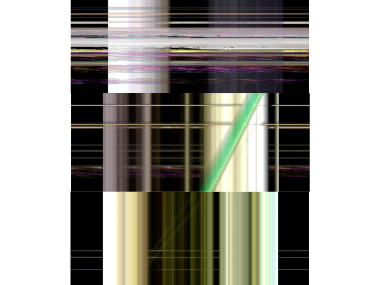
Libertad, Igualdad, Fraternidad, 2005
Series of 3 digital color photographs
30 x 71 cm
Carlos Trilnick Archive
This series of photographs is generated from incomplete and defective files downloaded from the Internet, a result of poor connectivity. To create these images, the artist takes as a starting point the metadata circulating internally within the programs that underpin the global force of technology networks. They reveal what is unseen but exists within the constantly moving circuits of computer access in a visually accessible format.
In the emergence of the Internet, one of the pillars upheld by its inventors was the unlimited access of users without any form of control. Today, we view these somewhat naive postulates without dismissing their ideological foundation. In this sense, the title alluding to the motto of the French Revolution refers to what the artist considers the three most relevant situations enabled by digital technology: the freedom of creation, the equality of opportunities to access resources, and the fraternity that enables the formation of networked communities.
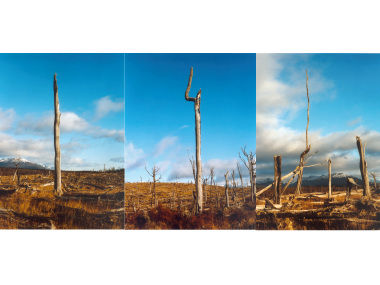
Tierra del Fuego, 2006
Triptych and series of three color photographs
Triptych of 100 x 90, two photos of 70 x 50 cm, and one photo of 50 x 70 cm.
Carlos Trilnick Archive
In the photographic series, the triptych Tierra del Fuego depicts the energy desolation that remains after the destruction of a lenga forest, a tree native to this geographical area, caused by the action of a voracious intentional fire. The mortality of the tree species that make up the altarpiece conceived by the artist is portrayed on a support characteristic of the artistic period of the Middle Ages.
The monumental landscape of the south and its natural beauty contrasts with the silhouettes of these standing dead trees. This triptych engages in a dialogue with three analog direct shots that show a broader scene of the same ravaged forest.
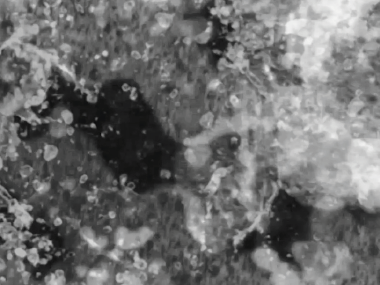
No se puede postergar el tiempo, 2018
Video, 5’17”
Archive Carlos Trilnick
This video captures, at various moments, the overlay of the artist's feet, creating the illusion that he is walking on the sea in moments that appear and disappear. These moving images, from a poetic perspective, prompt reflection on the crisis faced by immigrants and refugees, conveying an explicit message of solidarity. In the artist's words: "Jesus walked on water (Matthew 14:22-33), and Moses parted the sea to free his people from slavery (Exodus 14). Today, thousands of immigrants are not granted that 'miracle,' and they drown while trying to cross the Mediterranean Sea to save their lives. Time cannot be postponed, neither can injustices nor wars."
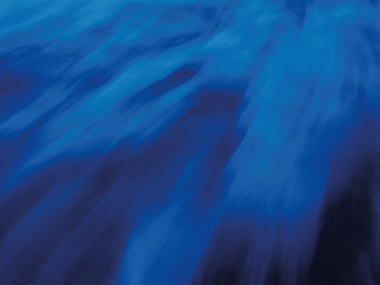
Mar, 2003
Series of 3 color photographs
100 x 128 cm
Carlos Trilnick Archive
This direct-shot photographic series captures the southern seas of Argentina. The artist immersed himself in the sea with a camera in hand, waiting for the right sunset light to capture the desired image based on movement and the play of light. The result of these walks in the water yields a visual interplay of abstract, almost painterly images, as the artist states: "The waves break while I am inside, creating this interplay of strong planes, with a lot of movement."
Interview to Marcela Römer, curator of the exhibition
What moment or stage of Trilnick's production do the selected works represent?
The intention is to show a timeline, starting with one of his early works - "Viajando por América" from 1989 - to his unpublished work, which is "Zona Cero." The five selected pieces obviously do not cover the trajectory of an artist like Carlos Trilnick over more than 40 years. It is very difficult for the audience in a single room to see his entire career, but in any case, "Viajando por América" showcases technology very typical of its time, quite advanced. Carlos had studied in Israel during his political exile, and when he returned to Argentina with the restoration of democracy, he brought an advanced background for what was happening here. This work is very important also because it expresses very specific ideological intentions that he maintained throughout his life.
The works have a remarkable contemporary relevance...
We agreed to showcase unpublished and current works such as "Zona Cero," where he works with virtual reality, a topic that was just beginning to be discussed when he started researching, and in the public university, with his working group. We also found it extremely interesting to include the "Minas antipersonales" project, the exhibition he did at the University of San Diego in 2009, given what is happening today in the Gaza Strip and Ukraine. I say "we" in the plural because we formed a small team with Mónica, his widow, his daughter Zoe, and Luis Campos, his colleague at the university, to discuss together what was most suitable for this exhibition. The installation of the landmines dialogues very well with the photographic series of the forests: the viewer can imagine the desolation of stepping on one of those mines that remain in the world, causing serious accidents, deaths, mutilations, etc.
What importance did support and discourse have in Trilnick's production?
This selection is called "Political Landscapes" because, for him, the ideological aspect was crucial. In his case, this interest always had to do with social and political movements. Many of his works were subtle or sometimes direct denunciations, such as "Minas antipersonales," which directly addresses the issue of landmines worldwide; others are more subtle, such as the photographs of Tierra del Fuego, for example, or the other photographic series about metadata on the Internet. For Carlos, it was crucial that technology did not overshadow the concept, that it was not the first thing to impact the viewer because the concept came first. Technology was a tool to convey a thought. Of course, he loved using it and was a pioneer in the field, but if he didn't need the latest LED screen, it didn't matter; he used a resource in line with the concept of his work. He passed on this balance to his students at the University of Buenos Aires. And that's what I learned from him: you don't have to use the latest technology if you don't need it because it can kill the essence of your work. Like a good artist who works with memory, he had great respect for his personal, family, and ideological matters. He remained consistent until the end. He never stepped back; he was always there, on the front lines, not without reason he had to leave the country during the dictatorship.
In which medium did he consider he could express himself better?
In photography, and in "technological works," to generalize, because it's very broad. He was interested in every innovative tool that appeared. He didn't see it as a mere novelty but as a possibility to express himself differently. Why wasn't he interested in painting? He has some small unpublished drawings and paintings in his archive, but for him, the most interesting aspects were photography, installations, and computer-based accesses. This has to do with his time at the university in Israel, which gave him a different perspective on art. When he returned to Argentina, he poured all of that into his work and, of course, into his daily life.
What do you think Carlos Trilnick would say today about the use of artificial intelligence as an artistic tool, and a possible "replacement" for "human" intelligence, the one that draws on memory and history, which he defended so much?
Difficult question because we were able to talk very little about the topic before he passed away. But I think he would continue to think the same: that it is an "other." Artificial intelligence is like another entity that is there, obviously not replacing the human being, but in two years or more, one, five months... Today, it is a very present and strong "other." It should not be ignored, but in no way will it replace the human, neither memory, nor ideological structure, nor anything.
Entre la migración tecnológica y la presentificación del pasado
Acercamiento a la obra de Carlos Trilnick
By Mónica Acosta, in Revista La Fuga, Chile
"Trilnick has undertaken a journey that begins with a voluntary stay in Israel during the military dictatorship. His intention was to study film, but he won a scholarship that led him to study photography at the Neri Bloomfield Academy of Design and Education. His initiation into design stemming from his photographic vocation was early and serendipitous. In 1982, he was invited to hold his first exhibition at the White Gallery in Tel Aviv, a gallery that also purchased the photograph 'Rosa y Raúl' for its permanent collection: a black and white image, of a medium scale between whites and grays, capturing a space that does not close within the limits of the frame but seems to extend beyond. In the photo, at a medium distance, his father is seen, and further back, his mother. Separated by a line that reaches the horizon, the father appears to be looking at the camera, while the mother, on the other hand, is walking towards the horizon with her back turned. There is no diegetic scene, no figuration except for the existence of those tiny figures in the infinite space—beings that seem to convey something about the ineffable and ungraspable nature of existence. Trilnick has undertaken a journey that, taking him out of his space and time, brings him back, already in 1983, to a country slowly recovering its democratic vocation. The forms of memory, unfinished landscapes, biographical cuts, historical embeddings, bodies in infinite space, digital interventions in family, genealogical, historical images, were already a certain intuition in the artist's project that started from Rosario to go to Israel and returned to become a reference in video art."
Memorias del presente
Por Rodrigo Alonso
"If we quickly review the artistic trajectory of Carlos Trilnick, it won't be difficult to confirm his preference for photography and video as mediums for his work. However, a slightly more careful look cannot help but observe that his approach to these mediums has been—and continues to be today—eminently plastic.
Certainly, his education at the "Nery Bloomfield" School of Design in Haifa is part of the explanation. But to this background, we must add the artist's determined awareness of the mediums and paths his work would take. Perhaps one of the greatest contributions of the aforementioned school should not be attributed strictly to the academic aspects, but to the opportunity it offered young Trilnick to experiment with technical means not yet extensively explored in the field of audiovisual investigation."
El oficio de la distancia acerca de la obra de Carlos Trilnick
By Ticio Escobar, in the book Carlos Trilnick, edited by Museo Castagnino+Macro
"Carlos Trilnick confronts the conflict between the order of form and the urgency of pressing content by measuring, in each case, the aesthetic component. He regulates and weighs its action according to the need to affirm an ethico-political position: his commitment to a harsh reality, marked by the critique of social exclusion and globalized violence, as well as the denunciation of any authoritarian model and any form of discrimination. It is a complex operation, capable of navigating both the seduction of pacified beauty and the literalness of pure denunciation. It is a bold operation: he rigorously works on visual representation and daringly experiments with formal elements, making these operations devices of enunciation and discourse. He knows that the silence of poetry is a safeguard against the muteness of pure form and the stridency of unrestrained shouting, of continuous sound. That's why he exposes himself to obviousness and stops just in time at the limit: he veers off; seeks the detour, the loss of the figure; denies, with a brief gesture, the inertia of meaning. That's why he dares to assume a critical stance against injustice and does so in a more radical way than an artist can, through the detour of what is stolen from language. Just as the narrative is about to conclude, Trilnick introduces a twist that derails its course and refers to other levels of meaning. Narratives, critiques, and concepts are intercepted by swift operations that introduce mediations, cause short circuits, and prevent the message from being deciphered: preventing the event from becoming an event in the key of pamphlet, information, or spectacle."
Indeterminaciones del paisaje
By Fabián Lebenglik, Página 12
"The genre that Trilnick chooses for his exhibition, and has been working on for some time, is that of landscape, taken as an artistic category. From this relative starting point (in any case, a "middle" starting point), Trilnick creates a series of twilight photographs, dynamic and highly plastic, engaging in a dialogue with both the genre of pictorial and photographic landscapes, particularly exploiting the inaugural and 19th-century intersection between painting and photography. The exhibition features a set of photos with a magmatic and fluid image that oscillate between the recognizable (trees, water, horizon, cloud...) and the unrecognizable, almost reaching a gestural blur. With impeccable refinement in color and image treatment, the artist pushes other boundaries as well. He dilutes and abstracts the image until it reaches the precise point of intersection between mobility and immobility, composition and casual exercise. Trilnick's photography is a fleeing image, the result of a shift and a journey, the outcome of the gaze of a frequent traveler.
The photographer generates and captures exploratory movements of twilight light, as exercises in romanticizing the landscape, where darkness introduces a subtly dramatic component. In the process, he incorporates photographic art as part of an expanded pictorial spectrum. His photographs create a poetic and provocative relationship between the notion of the instant and eternity, positioning them as complementary categories or, in any case, as aspects of the same visual and psychological process: duration and fixation would be abolished as poles, in search of a new reading of time in which photography becomes a skillful instrument."